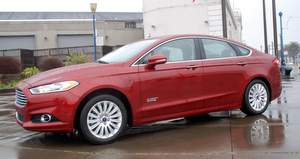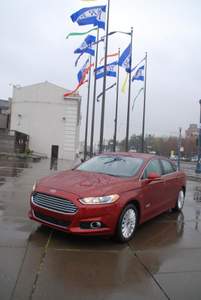
Ford is making a concerted push towards electrification, a key part of its strategy to boost fuel economy across its lineup. The Ford Fusion Energi, which Clean Fleet Report recently had the opportunity to sample for a brief test drive, is the centerpiece of a five-vehicle fleet that also includes:
- Focus Electric (full electric)
- C-Max Energi (plug-in hybrid)
- C-Max Hybrid
- Fusion Hybrid
In addition to its electrified vehicle push, Ford is deploying gasoline direct injection (which is markets as EcoBoost), which allows downsized fuel-efficient engines that deliver the same power as larger ones. For its trucks Ford is using clean diesels to deliver better fuel economy, along with a variety of other gas-saving technology throughout its lineup of cars and trucks. All told, Ford is making a strong move to get its products to the front of the line when consumers are thinking about fuel economy.
Ford’s Manager of Hybrid Control Systems, Tom Gee, said Ford has five goals with its electrified vehicles:
- Be affordable
- Save money over time (offset any price premium)
- Be sustainable
- Have a self-image that makes a visible statement
- Be a better choice (than the competition)
Ford makes a point that it is not new to the electrified vehicle game and uses the Fusion Hybrid as its proof point. The 2013 model is its second generation, offering better fuel economy (47 mpg) than the first generation while retailing for $1,600 less. The Fusion Hybrid starts at $27,995. Ford claims that with current gas prices, the vehicle’s initial price premium (compared to a similarly regular Fusion) can be paid back with savings at the pump in 3.4 years, significantly better than its main competitor, the Camry Hybrid. Ford says the Camry, which has a starting price for its hybrid model of about $1,000 less than the Fusion, takes longer to pay back its premium cost.
But Ford’s ace is the Energi model, a plug-in hybrid that delivers around 100 mpge (miles per gallon equivalent since it can run in EV-only mode for up to 21 miles). Camry doesn’t have a comparable model although Toyota does offer a plug-in version of the Prius. Honda just introduced a plug-in version of its Accord, which is a direct competitor in the midsize segment, which Clean Fleet Report tested a short while ago. The Fusion Energi slots between the two in price, though it’s closer to the Honda (about $1,000 less) while offering better fuel economy that either and a significantly larger interior than the Prius. The Fusion Energi will retail for $38,700 according to Ford while the Prius Plug-in starts at about $32,000 and the Accord Plug-in is $39,780.
Second Generation
The Energi benefits from some of Ford’s second generation hybrid advances, which deliver a batter pack that is 50% lighter and 25-30% smaller than the first generation models. Ford made it clear that these advanced battery packs (assembled by Ford from Sanyo cells) are not only delivering better efficiency, but also are helping Ford to lower the costs of its electrified vehicles.
Along with its EV technology, the Fusion Energi also offers a suite of connectivity options and a broad list of technology that can be added to the basic vehicle. The MyFord Mobile technology is designed to give the Energi driver a broad range of information about the state of the battery as well as a wealth of data about the vehicle’s performance. Much of the same information is on display in the dash of the Energi as Ford and other auto companies attempt to give drivers of these new technology vehicles as much feedback as possible. As has been the case since the Prius introduced a dashboard competition of building bars that signified environmental achievement, the tools for measuring the various attributes of the car are becoming more and more numerous. After our brief test drives, we were able to get a readout of total miles driven, extra miles contributed by regenerative braking and cumulative miles per gallon. The braking instant readout in particular has the capability of quickly teaching a driver the technique that will derive maximum energy from stopping the vehicle. The information – and distraction – potential is high, but like many modern devices, the learning curve could be steep to truly pull out all of the available data.
Additional information available through the MyFord system, as explained by Bill Frykman, Connected Services Product and Business Development Manager, could be displayed or relayed to a smartphone, alerting the Energi owner if someone has unplugged their vehicle, charging the battery for a set departure time or having it charge at the best rate time, finding one of 11,500 public charging stations and logging trips and charging episodes. Frykman made note, like most software, the current version of MyFord has been enhanced since it was first introduced with the Focus Electric last year.
A Short, Wet Drive

While driving the vehicle, the relatively large vehicle felt nimble enough while navigating rainy downtown San Francisco streets. Even under EV power alone, the car had plenty of power (35 kW worth) to take on the city’s notorious hills. With the 2.0-liter, 141 hp gasoline engine, either on its own or augmented by the electric drive, the car has a 620-mile highway range. The transition from EV drive to gasoline was seamless, as is the standard these days and even with the gas engine running the cabin was quiet.
The biggest disappointment with the car, which is where you start to see the trade-offs that often come along with most new technologies, is the trunk. The hefty 7.6 kWh battery dominates the space, leaving a small pass-through shelf to the back seat and room for a couple small bags. If an Energi model is to be pressed into taxi service, as the original Fusion Hybrid was, our recommendation would be to use the C-Max model, even though it, too, loses some of its functionality in order to add the electric capability.
The biggest plus for the Fusion Energi is its ability to deliver a fairly luxurious midsize sedan ride and performance along with the ability to drive up to 21 miles as an electric vehicle and more than 600 in gas-electric mode. Yet another positive for the Ford is all that technology is delivered in a package that is one of the best-looking cars on the road, borrowing more than a few styling cues from the former Ford stable-mate Aston Martin. It may waver on making it on the affordability scale, even after federal and state incentives, but the environmental and fashion statement it makes is very solid.

0 thoughts on “Ford Expands Energi Lineup of Part-time Electric Cars”